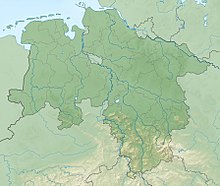Flögeln Prehistory Path
Coordinates: 53 ° 38 ′ 51 ″ N , 8 ° 47 ′ 29 ″ E
The Flögeln Prehistory Path lies between Flögeln and Fickmühlen in the Cuxhaven district in the Elbe-Weser triangle in Lower Saxony . The approximately two-kilometer circular route was established in 1973 in the Flögelner Holz state forest and leads to 30 prehistoric (including 26 burial mounds) and medieval (trail tracks and high fields ) monuments . The largest burial mound has a diameter of approx. 25 meters and a height of approx. 2.5 meters. A part of the burial mound group is probably from around 1800 BC. BC originated. In addition, the contours of medieval paths and fields can be seen in the landscape.
The passage graves
The finds suggest the possible simultaneity of both graves. Despite their location, the basic construction is the same , once in a round hill and once in a long bed .
Bunny 131
The large stone grave "Flögeln 131" or "Flögeln 2" with the Sprockhoff no. 610 was made between 3,500 and 2,800 BC. And is a megalithic system of the funnel beaker culture (TBK).
It was under a four meter high round hill, with a diameter of 29 meters. The inside of the burial chamber measures 5.8 meters in length and has a width of about two meters. It was built from ten bearing stones on which five cap stones rest. The access is a short corridor made of two girders and two cap stones.
When “rummaging through” the interior one found mainly deeply engraved ceramic shards of the funnel beaker culture, but also an ax, a spearhead, part of an ax, all made of flint.
Main article: Stone box of birds
Fowl 132
The large stone grave "Flögeln 132" or "Flögeln 1" with the Sprockhoff no. 609 is about 15 meters away. Like the large stone grave 131, this facility was excavated in 1882 and 1898.
This large stone grave was known for a long time and probably served as a “quarry” from the 17th century, when it is proven that several other stone graves, including the large stone grave “Dansensteen” in the area, were destroyed. The rectangular barn bed was 19 meters long and eight meters wide. Of the dense stones in the enclosure, 17 are left. The inside of the chamber is 8.6 meters long and up to 1.7 meters wide. It was built with fourteen bearing stones and six cap stones. Four of the capstones are still preserved, two more have been blown up. The two meter long and 0.7 meter wide corridor consists of four bearing stones and two cap stones.
Finds
In 1973 both plants were examined again by H. Aust. At Flögeln 131 and 132 piles of stones appeared on a rock slab in front of the corridor. This pile contained: a grooved half double ax ("Hanoverian style", according to Brandt group A of double axes), 41 cross-edged arrowheads. Over 700 core stones, devices and chips made of flint and over 1,100 shards.
A cremation from the Younger Bronze Age was found in the hill mantle. The man was buried about six feet tall, lying on his left side with his head at the southeast end of the grave with his legs crouched. Although the burial was carried out without gifts, there were fragments of the early 2nd millennium BC over a stone box in the hilltop structure. Chr. Or the late Neolithic. Comparable graves are known in large numbers in Schleswig-Holstein and Denmark; in the district of Cuxhaven the facility is unique.
See also
literature
- Hans Aust: The "Flögeln Prehistory Path". A model case of the preservation of monuments, its motivation and problem. In: News from Lower Saxony's prehistory. Volume 42, 1973, pp. 385-391 ( online ).
- Ernst Sprockhoff : Atlas of the megalithic tombs of Germany. Part 3: Lower Saxony - Westphalia. Rudolf-Habelt Verlag, Bonn 1975, ISBN 3-7749-1326-9 , pp. 4-5.
Web links
- The Megalithic Portal: Grave 1 , Grave 2
- cruptorix.nl :: grave 1 , grave 2
- Prehistory path
Individual evidence
- ^ Number of the archaeological land survey


